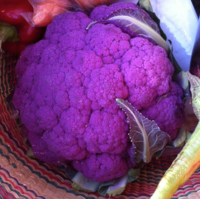
Photo from wikipedia
Abstract Anthocyanin biosynthesis is induced by ethylene in most fruit species. However, the hormone function in peach skin red coloration remained unclear. We investigated the effect of ethylene and ethylene… Click to show full abstract
Abstract Anthocyanin biosynthesis is induced by ethylene in most fruit species. However, the hormone function in peach skin red coloration remained unclear. We investigated the effect of ethylene and ethylene action inhibitor (1-methylcyclopropene, 1-MCP) on color development and anthocyanin content in postharvest peach as well as mechanism behind this. The results showed that ethylene decreased total anthocyanin and cyanidin-3-glucoside accumulation and thus prevented the red coloration of fruit skin, whereas 1-MCP treatment had an opposite effect. The activity of all enzymes associated with anthocyanin biosynthesis (except 4CL), and expressions of their coding genes as well as the related transcription factors (TFs) were also affected oppositely by 1-MCP and ethylene. In addition, the activity of ANS and UFGT was positively correlated with total anthocyanin and cyanidin-3-glucoside content. The result implied that ethylene blocked anthocyanin biosynthesis by regulating the expression of upstream TFs, thus hampering the anthocyanin biosynthesis pathway. This is the first evidence pertinent to the inhibition of ethylene to the skin red coloration in postharvest peach. It also provides a technology (1-MCP application) to improve postharvest fruit coloration and quality.
Journal Title: Postharvest Biology and Technology
Year Published: 2022
Link to full text (if available)
Share on Social Media: Sign Up to like & get
recommendations!